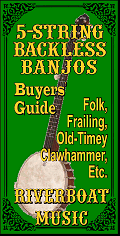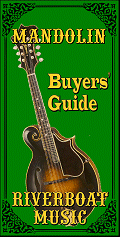Acoustic Instrument
Primers
What Kind of Guitar
Should I Start On?
What Kind of Banjo
Do I Want?
Evaluating and
Buying Used
Guitars
Setting Up
Fretted Instruments Whatever Happened
to the Banjo?
Beginning Five-
String Banjo
6-String Banjos
Banjo Pickups
Axes in my Life
What is a
Bluegrass Banjo?
Dean "Backwoods
Six" Shootout
Music Theory
Primers
Introduction
to Scales
Introduction
to Chords
Circle of Fifths
Other Articles
About Music
How to Give
Guitar Lessons
Musician or
Wannabe? Did God Really
Give Rock &
Roll to You?
Are You a
"Brand Bigot"?
Who Owns Folk Songs?
Historical Links
About the
National Road
The Story Behind
the Story - Real
People, Places,
and Events
About the Play
Play Home
What's New
Overview
About the
Music
About the
History
About the
Logistics
About the
Cast
Synopsis
About the
Set
About the
Author
Contact Us
Home





|

|



Beginning Five-String Folk Banjo - Part Eight - More 3/4 and More Chord Stuff
| Written by Paul Race for Creek Don't RiseTM and School Of The RockTM |
This is a follow-up to Lesson 7, 3/4 Time and More about Chords
. The truth is, you can't cover all there is to know about songs in 3/4 time in one lesson - there's just as much variety as there is in 4/4 songs. In this lesson we'll discuss a kind of slow 3/4 that is used in a lot of songs, and almost never explained properly. Because we're trying to avoid copyright issues, we'll use "Amazing Grace" for our example, but everything in this article applies equally to the old Hank Williams song "I'm so Lonesome I Could Cry," and countless other sad "bluesey" Folk, Pop, Country, and Bluegrass songs. We're also going to practice "sneaking" in more chords, and explaining why they work.
When songs slow down past a certain point, most Americans give those two notes different values - playing the first eighth note literally twice as long as the second one. It would be more "honest," to say that each beat has been divided into three eighth notes, and the middle one isn't played.
But most people think that's too much work when they're writing out scores. Many Swing, Jazz, and Blues composers just write out two eighth notes and trust the musicians to adjust on the fly. Sometimes they're put "swing feel" on the score in case you haven't caught on.
If you think that this sounds crazy or impossible, the next time you hear a bluesy song in 3/4 time, try saying "buffalo, buffalo, buffalo" in every measure and see if it doesn't fit perfectly.
We're going illustrate this by taking a song that was written a long time before the rythms we're discussing ever entered our country's musical vocabulary, but which is performed this way more often than not today, the hymn "Amazing Grace"
"Swing" Feel or 9/8 Meter?
All styles of North American traditional and popular music have a tendency to introduce syncopation of some sort. The kind we'll be discussing here is so common that a lot of folks do it without thinking about it. And that's subdividing each beat of a slow song into three pulses, not two.
 So far we've been using eighth notes to subdivide each beat into equal halves, the way they did in Europe. The little tab at the right shows an example of a banjo arpeggio played in "straight time." Click the little icon to hear it played.
So far we've been using eighth notes to subdivide each beat into equal halves, the way they did in Europe. The little tab at the right shows an example of a banjo arpeggio played in "straight time." Click the little icon to hear it played. 
 The most accurate way to show this would be to indicate a 9/8 time signature (or a 12/8 time signature for 4/4 songs). Each beat would be "officially" divided into three pulses, represented by eighth notes, and you wouldn't need to resort to herculean measures to show the relationship(s) between the notes within each beat. The little tab at the right shows an example of a banjo arpeggio played in "swing time." Click the little icon to hear it played.
The most accurate way to show this would be to indicate a 9/8 time signature (or a 12/8 time signature for 4/4 songs). Each beat would be "officially" divided into three pulses, represented by eighth notes, and you wouldn't need to resort to herculean measures to show the relationship(s) between the notes within each beat. The little tab at the right shows an example of a banjo arpeggio played in "swing time." Click the little icon to hear it played. 
"Amazing Grace" Before Syncopation
Nobody writes out "Amazing Grace" the way it is usually played today. In fact, in very old hymnals, it's harmonized all on one chord - usually G.

G-Only Accompaniment - As I mentioned, this song started out harmonized with only a G chord. And it worked, technically, because almost every note you hold for more than a beat is actually part of the G chord. To hear the melody accompanied by the straight 3/4 accompaniment, all on a G chord, click this icon:  You don't have to learn the song this way, so we don't even show the music, but if you want to try it, the PDF is here.
You don't have to learn the song this way, so we don't even show the music, but if you want to try it, the PDF is here.
G, C, D Accompaniment - Fortunately for more modern ears, some of those long notes (like the high D at the end of the second line) also worked on other chords, which let folks insert a little more variety into the arrangement. So even the most conservative arrangments of this hymn today add C and D7 (D7sus4 for banjo players).
The tab below this one is for the melody accompanied by the straight 3/4 accompaniment, with C and D7sus4 chords, the way it's usually printed in modern hymnbooks. And it wouldn't hurt you to try it once, at least. To hear this arrangement, click this icon:  To see the PDF file, click on the little score below.
To see the PDF file, click on the little score below.

Arpeggio Version - Just for the fun of it, we are also providing an arpeggio version, still in straight 3/4, with C and D7sus4 chords. If you're asked to accompany this song in a conservative church, or at a Celtic festival, this is a good way to do it. Although it will require either double-thumbing or four-finger picking, it wouldn't hurt you to try it once, at least.
To hear this arrangement, click this icon:  To see the PDF file, click on the little score below.
To see the PDF file, click on the little score below.

9/8 ("Swing") Version - Finally, we're presenting the same song with the same chords, but with the 9/8 time signature, to spell out exactly the kind of rythmic feel we're talking about. This is the one you need to pay attention to.
To hear this arrangement, click this icon:  To see the PDF file, click on the little score below.
To see the PDF file, click on the little score below.

9/8 Solo Version - In case you're anxious to play the melody on this song, we're providing a banjo solo version, incorporating the 9/8 accompaniment shown above. Some people find it a little tough, and you might have to try different ways of playing certain notes (like playing B to G by fretting the third string at the fourth fret and pulling off). But it will be good practice for a lot of other 3/4 songs.
To hear this arrangement, click this icon:  To see the PDF file, click on the little score below.
To see the PDF file, click on the little score below.

Adding More Chords
In many modern settings, even more chords are added. This is especially true when the song finds its way to a Country & Western concert, an African-American or Pentecostal church choir, or an Evangelical church "worship team."Relative Minor or "viii," Redux - One chord we're adding is an old friend, E minor, which is substituted for a G chord (a technique we used in our last version of "This Little Light of Mine" in Lesson 7). Again, Em is the "relative minor" to the G chord, so it shares most of the same notes and doesn't really clash if you happen to play them both at the same time. Going down to Em when you could stay on the G adds just a little more motion and "drama" to the arrangement.
About "5-1" Chord Progressions - The strongest harmonic progression in modern music is the movement between the Fifth (Dominant) and the First (Tonic) of the song. Many folks call this the 5-1 (or V - I) progression. That's why, for most songs in G, the next to the last chord is some version of D, usually a D7 (yes, on banjo we usually play a D7sus4, but stick with me). D is the Fifth (Dominant) of G. So a D or D7 to G progression has more "kick" than any other chord progression in the key of G. When it comes at the end of a song, it's especially powerful.
 About "7th" Chords - The "7" in the D7 chord refers to C natural, which has been added to a chord that usually includes D, F# and A. (It's the note circled in red to the right.) If you were using a D major scale, the seventh would actually be C#, so some folks call a C natural in a D chord a "flatted 7th." But guitar players just call it a "D7."
About "7th" Chords - The "7" in the D7 chord refers to C natural, which has been added to a chord that usually includes D, F# and A. (It's the note circled in red to the right.) If you were using a D major scale, the seventh would actually be C#, so some folks call a C natural in a D chord a "flatted 7th." But guitar players just call it a "D7."
 To modern ears, the extra note clashes a little with the rest of the chord, and we've learned to expect a "resolution," that is a chord change that reduces the tension. In 999 songs out of a thousand, a D7 will resolve to G. So the D7 to G harmonic progression (shown to the right) is even stronger than the D to G progression. (Alert readers will notice that you can turn our classic D7sus4 chord into a D7 chord simply by leaving off the fifth string.) To hear this progression, click this icon:
To modern ears, the extra note clashes a little with the rest of the chord, and we've learned to expect a "resolution," that is a chord change that reduces the tension. In 999 songs out of a thousand, a D7 will resolve to G. So the D7 to G harmonic progression (shown to the right) is even stronger than the D to G progression. (Alert readers will notice that you can turn our classic D7sus4 chord into a D7 chord simply by leaving off the fifth string.) To hear this progression, click this icon: 
In some circles, when someone says "Go to the Dominant" or "Go to the Fifth," you can almost count on that chord being a seventh chord, and the next chord being the tonic (1 or I) of the song.
Introducing the Secondary Dominant - But composers aren't satisfied with just having one killer chord progression in their vocabulary. So they often treat similar chord progressions as 5 to 1 progressions. 
In our arrangement below, we do it by treating the G-to-C progression as a 5-1 progression. And in a way it is - G is the Fifth of C just as D is the Fifth of G.
To make the progression even stronger, we are changing the G chord to a G7 by adding an F at the top, as shown in the little chord chart to the right. So the transition from the G to the C in the first and third line is even more obvious. 
When a chord that is not the true Dominant chord for this key is used this way, it is called a "Secondary Dominant." In the arrangement below, G7 is a "Secondary Dominant" because it temporarily works the same way the "real" Dominant chord (D7) does.
The G7 to C harmonic progression is shown to the right. To hear this progression, click this icon: 
 Your First Barre Chord and the "Fifth of Five" - The chord to the right is A7. It looks funny because you don't fret it with your fingertips - you fret it by laying your first finger across all four strings to fret them. The technical name for this is a "barre chord." There are other barre chords that are more complicated, but this one is one of the most useful. To hear this chord, click this icon:
Your First Barre Chord and the "Fifth of Five" - The chord to the right is A7. It looks funny because you don't fret it with your fingertips - you fret it by laying your first finger across all four strings to fret them. The technical name for this is a "barre chord." There are other barre chords that are more complicated, but this one is one of the most useful. To hear this chord, click this icon: 
A is the 5th (Dominant) of D, just like D is the 5th of G and G is the 5th of C. In the arrangement below, we're using the A7 chord to D7sus4 progression the same way we used the G7 to C progression above. So it is a "Secondary Dominant," also.
On top of that, A is the Fifth of the Fifth of the song (D). So it's a special kind of "Secondary Dominant" that is often called the "Five of Five" (or V of V). This is actually the most popular kind of "Secondary Dominant," and it's used in every key in every kind of music. Once you recognize how it works, you'll start hearing it everywere, and you'll be able to "catch on" quicker when you're trying to learn a new song just by listening to it.
Introducing the "Circle of Fifths" -  In fact, all twelve major keys are connected this way. B is to E as E is to A, as A is to D, as D is to G, as G is to C, and so on. If you keep going through F, Bb, Eb, Ab, Db, and Gb, you've actually worked your way back to the beginning, because another name of Gb is F#, and F# is to B as B is to E, and so on.
In fact, all twelve major keys are connected this way. B is to E as E is to A, as A is to D, as D is to G, as G is to C, and so on. If you keep going through F, Bb, Eb, Ab, Db, and Gb, you've actually worked your way back to the beginning, because another name of Gb is F#, and F# is to B as B is to E, and so on.
The whole chord cycle is called the "Circle of Fifths" (or Fourths, in some populations).
Dedicated guitar players, horn players, pianists, fiddlers, bass players, and composers learn all of these chord relationships eventually. For one thing, it helps immeasurably when you're trying to learn new songs, or write or arrange your own.
 For more information about the Circle of Fifths and how it can help you become a better accompanist, songwriter, performer, and all-around general musician, check out our two Circle of Fifths articles that start here. They include a free handy, downloadable tool to help you dial up the chord families for any song in any key.
For more information about the Circle of Fifths and how it can help you become a better accompanist, songwriter, performer, and all-around general musician, check out our two Circle of Fifths articles that start here. They include a free handy, downloadable tool to help you dial up the chord families for any song in any key.
6-Chord Accompaniment Version - To give you a sense of how these extra chords help keep things flowing right along, here's an accompaniment of our example song with Em, G7, and A7 added in. This is a very common Country and Western and Pop interpretation of this song. In addition to the chords we just listed, we also included a little "church cadence" and the end, bumping up to C and coming back on the last note.
To hear this arrangement, click this icon:  To see the PDF file, click on the little score below.
To see the PDF file, click on the little score below.

6-Chord Solo Version - Here's the solo version of the arrangement above. If you're ever leading this song in group singing, you could start out with the solo, then use the accompaniment while peole are singing.
To hear this solo arrangement, click this icon:  To see the PDF file, click on the little score below.
To see the PDF file, click on the little score below.

Blues Lick Version - This is your "bonus track" for this lesson. When I play a slow bluesy solo like this one, I can't help putting some of the old Bluegrass "blues licks" in somewhere. The truth is I never put them in the same place twice. The "licks" I added to this arrangment are just suggestions, things to try. But hopefully it will help you come up with your own ideas the next time you stumble across a song with this sort of feel.
To hear this solo arrangement, click this icon:  To see the PDF file, click on the little score below.
To see the PDF file, click on the little score below.

Chord Chart
Well, I promised you more chords. There are at least 48 chords that can be used on a 5-string banjo tuned to the key of G. Closer to 392 when you start counting all the reasonable variations. However, most banjo songs only use a few chords, and even the most complicated ones seldom stray from the chords we've shown you so far.In case you're trying a song that goes a little further afield, we're providing you with a chart of other chords that you might possibly encounter playing a G song in G tuning on a 5-string banjo. If you want a handy wall chart you can print on your printer, click the chart below.

Conclusion
Though I wrote the last several arangements out in 9/8 time to make the timing as clear as possible, most songs that you will encounter with this sort of feel will be written out with straight eighth notes. It will be up to you to decide just how much "swing" to apply.If you've gotten really "solid" on all the material so far, you will be able to keep up with a lot of amateur banjo players, and you're better than quite a few. As you go back over the songs we've done so far and experiment with other people's tabs and techniques, try to remember to pay attention to things like chord progressions and "blues licks" that you can use to learn new songs and make them your own quickly.
You will encounter tabs for the songs I've presented so far that are slightly or even radically different. Don't let that throw you. There is no one way to play any song no matter what folks tell you. And as you gain confidence, you'll find that there are a boatload of songs you can figure out for yourself, just using the tools we've given you so far.
Whatever you do, whatever your age, try to play at least 20 minutes a day, even if it's mostly review. When you hear folks with lightning-fast speed, a lot of that is due to "muscle memory," training your brain and your hands to work together.
Our current plans are for the next three chapters to help you get out of the "key of G only" rut that keeps so any banjo players from jamming with other musicians. And believe it or not, learning to play in other keys will actually give you ideas for things you can do in the key of G when you get back to it.
In the meantime please contact us if you have any questions or hit any brick walls.
All material, illustrations, and content of this web site is copyrighted © 2001, 2002, 2003, 2004, 2005, 2006,
2007, 2008, 2009, 2010, 2011, 2012, 2013, 2014, 2015 by Paul D. Race. All rights reserved.
Creek Dont' Rise(tm) is a participant in the Amazon Services LLC Associates Program, an affiliate advertising
program designed to provide a means for sites to earn advertising fees by advertising and linking to Amazon.com.
For questions, comments, suggestions, trouble reports, etc. about this play or about this web page, please contact us.
| Visit related pages and affiliated sites: | ||||||
| - Music - | ||||||

|
 |
 |

|

|

|
|

|

|

|

|

|

|
|
| - Trains and Hobbies - | ||||||
 |

|

|  |
 |

|
|
| - Christmas Memories and Collectibles - | ||||||
 |

|
 |

|
 |

|
|
| - Family Activities and Crafts - | ||||||
 |

|

|

|

|

|
|
